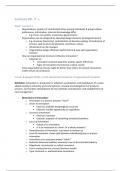Summary OFI, P. v.
Week 1 Lecture 1
- Organisations: systems of coordinated action among individuals & groups whose
preferences, information, interests & knowledge differ.
o E.g. firms, non-profits, universitas, governments…
- Organisations can be designed by adjusting design elements (managerial levers)
o E.g. structure (hierarchy), centralization of decision-making, formalization of
process, task structure & allocation, incentives, culture
o All elements can be changed
o Organization design influences performance & now well organization
function
- How can organizational structures influence innovation?
o Depends on:
▪ innovation outcome (quantity, quality, speed, efficiency)
▪ Types of innovation (incremental, radical, novel)
- Some organizational choices might be better than others for certain innovations
under certain circumstances
Crossan & Apaydin (2010): A multi-dimensional framework of organizational innovation
Definition: Innovation is: production or adoption, assimilation, and exploitation of a value-
added novelty in economic and social spheres; renewal and enlargement of products,
services, and markets; development of new methods of production; and establishment of
new management
- Dimensions of innovation:
o Innovation as a process answers “how?”
o Driver to innovation:
▪ Internal: available knowledge & resources
▪ External: market opportunity or regulations
o Source to innovation:
▪ Internal: invention
▪ External: adaption of something invented elsewhere
o Locus of innovation:
▪ Extent of an innovation
▪ Is it an innovation to a firm? Or a whole network?
o View/direction of innovation: top-down or bottom up
o Level of innovation: shows split between individual/group or process
innovation
o Innovation as an outcome answer “what?”
o Referent dimension (defines newness): new to firm/market/industry
o Magnitude: incremental vs radical innovation
o Form: product/service, process/business model
o Type: technical vs. administrative innovations
, o → outcome of innovation is crucial, process is necessary but not sufficient as
an innovations
- Determinants of innovation
- 1. Leadership (upper echelon theory)
o Leaders provide support & guidance to the creative stage & poses ability to
create conditons for implementation of innovation
o Upper echelon theory: connects characteristics of leaders with their
behaviour to influence organizational outcome
- 2. Managerial levers (RBV & Dynamic capabilities)
o Construct that has firm-level supporting variables of innovation
o 5 types of managerial levers:
▪ Mission, goal, strategy: give direction to follow
▪ Structures & systems: give necessary support to innovation
▪ Resource allocation: give necessary support to innovation
▪ Organizational learning & management support: help maintain
innovation
▪ Organizational culture: management support: help maintain
innovation
- 3. Business Process (Process Theory)
o Initiation phase: awareness & attitude towards new ideas
o Portfolio management: making strategic, technological & resource choices
that govern project selection & future shape of organisation
o Development &
implementation:
sequentially follows
innovation
generation/adoption
decision
o Project management:
processes that turn
inputs into
marketable
innovation &
comprise both
sequential &
concurrent activities
o Marketing &
commercialization:
final innovation
process
Lecture 2: Organizing knowledge & capabilities
- Knowledge base & Innovation
o Consist of many knowledge elements (building blocks of innovation) that are
spread over the whole organisation
o Important driver for its innovative ability
o E.g. intel patents as knowledge structure
, o Innovation can come from adding new knowledge elements or from
recombining existing ones
- 3 main challenges in organizing knowledge
o Knowledge transfer problem: knowledge is dispersed in organisation & must
be transferred in order to be used
o Knowledge creation problem: new knowledge elements need to be added to
drive innovation
o Knowledge retention problem: acquired knowledge needs to be retained (e.g.
employees need to stay within company & use the knowledge to not forget)
- Knowledge management outcomes:
o Creation: new knowledge is generated in organisation
o Retention: embedding knowledge in a repository (lager) so that it exhibits
some persistence over time
o Transfer: experienced acquired in one part affects another
- Knowledge in organizational setting
- Knowledge typologies
o Nature of knowledge: tacit (complex, difficult to articulate, codify, store &
transfer) vs. explicit (easily, articulated, codified % stored, thus can be
transferred), internal vs. external, public vs. private
o Content of knowledge: technological vs. managerial vs market
- Levels of knowledge: (locations of knowledge)
o Individual
o Group (team sports)
o Organizational (e.g. routines for firefighters)
o Inter-organizational (e.g. alliances & their interaction)
- Knowledge as a process:
o Knowledge is a dynamic human process of justifying personal belief towards
the truth
- Organisational routines
o Repetitive, recognizable, interdependent patterns of action, multiple actors
- Organizational capabilities
o Knowhow that enables an organizations to exercise their
main activities
o Collection of routines that confers upon an organizations
management a set of decision options for producing
significant outputs of a particular type
, - Capability vs. routine:
o Capability: collection of routines, substantial size, managerial decision (e.g.
expanding restaurant in other location(large scale & managerial decision))
o Routine: building block of capability, any size & significance, automatically
triggered (e.g. order French fries at MCs, (small scale, frequently repeated,
triggered by customer))
- Dynamic vs. ordinary capabilities
o all capabilities are collections of routines
▪ Ordinary: operational routines that describe the operational function
of a company
▪ Dynamic: search (innovation) routines that modify operational
routines and guide the creation of new routines
o → changes in existing capabilities are an outcome of dynamic cababilites
o D.c. are refined in each company
- How do firms develop innovation capabilities?
o Prior experience: experience accumulation (learning mechanisms)
o Purposeful learning investments: knowledge articulation & codification
(learning mechanisms)





